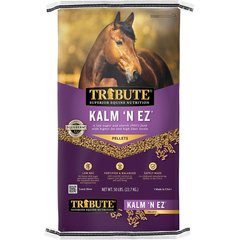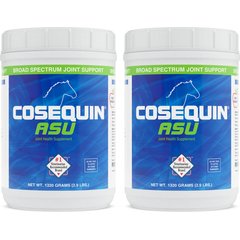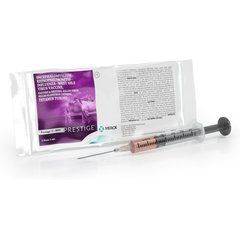Proud Flesh in Horses
What Is Proud Flesh in Horses?
Proud flesh is the overproduction of granulation tissue in a horse. Granulation tissue is the material that the body makes during wound repair. Medically, this condition is known as “exuberant granulation tissue.” It is recognized by its red, bumpy, cobblestone appearance.
Proud flesh is a very common condition in horses–occurring most often on the horse’s legs, below the knee and hock. Full skin thickness wounds that have not been closed with sutures and are left to heal on their own are at risk of developing proud flesh.
Wounds on your horse should be addressed with urgency. Any wound over a joint or tendon constitutes an emergency. For optimal healing, wounds should be sutured closed within eight hours of their occurrence.
Shop Horse Products
- Tribute Equine Nutrition Kalm N' EZ Pellet Low-NSC, Molasses-Free Horse Feed, 50-lb bag$25.49Chewy Price
- Nutramax Cosequin ASU Powder Joint Health Supplement for Horses, 2.86-lb tub, bundle of 2$279.98Chewy Price
- Absorbine ShowSheen Instant Detangling Hair Polish & Detangler Horse Spray, 32-fl oz bottle$17.84Chewy Price
- Prestige 5 + WNV Vaccine for Horses, 1-mL syringe$53.99Chewy Price
Symptoms of Proud Flesh in Horses
-
Redness
-
Roughness
-
Pebble or cobblestone appearance
-
Crumbly
-
Wound contains blood vessels
Causes of Proud Flesh in Horses
There are a few circumstances that may cause proud flesh development in horses:
-
High motion areas; e.g., near joint
-
Moist, warm environments
-
Low oxygenated areas
-
Infection
-
Foreign material; e.g., dirt, hay, grass
-
Medicine or treatment that delays skin growth
-
Loss of skin near wound
Horses and ponies are more likely to make exuberant granulation tissue than other species, but ponies are less likely to develop proud flesh than horses.
Wounds on the lower legs are more prone to develop proud flesh. This is because there is usually not enough skin to close these wounds by suturing, they are close to the ground and have a hard time staying clean, and there is a lot of motion in these areas. Two areas that are particularly prone to proud flesh are the pastern and the cannon bone region.
How Veterinarians Diagnose Proud Flesh in Horses
Your veterinarian can make a diagnosis of proud flesh by the appearance and texture of the tissue and with a history of a wound in that area. Occasionally, other disease processes, like sarcoids, habronema, fungal infections, or tumors may appear similar to proud flesh. If your veterinarian is suspicious that there is something more complex happening, they will take a sample of the tissue and send it to the laboratory for analysis.
Treatment of Proud Flesh in Horses
The first step in managing proud flesh is to make sure it is clean and free of any foreign material. Applying a topical antibiotic may be necessary to treat infection.
Treatment depends on the severity of the proud flesh. With minor tissue over-production, applying a steroid ointment and a bandage may be enough to stop its growth and allow the skin to heal over the wound. Your veterinarian will give you instructions on how to apply the ointment and change the bandage as needed. Leaving the bandage on longer than necessary may be counterproductive and promote proud flesh development versus stopping it.
Moderate to severe proud flesh will require surgery. The granulation tissue needs to be cut back until it is flat with the skin edges so that the skin can grow over it. Your veterinarian will do this with a sterile scalpel blade. The granulation tissue does not contain any nerves but does have blood vessels. Since there are no nerves, anesthetic is not necessary and removing the proud flesh will not be painful. Cutting back the proud flesh will cause it to bleed and bandaging material needs to be ready to control the bleeding. Once the exuberant granulation tissue is trimmed back to the level of the skin margins, you will be able to manage it like you would for minor tissue overproduction.
Wounds over a high-motion area like the knee, hock, or pastern may benefit from a cast in the initial stages of healing to prevent excessive motion. However, if the cast is left too long it may become detrimental by creating an environment that promotes granulation tissue, like a low oxygenated environment and risk of moistness.
There are over the counter (OTC) remedies on that market that claim to treat proud flesh, but the best thing to do is consult your veterinarian to develop a treatment plan.
Recovery and Management of Proud Flesh in Horses
It may take a couple of weeks to several months to recover from proud flesh, depending on the severity of the tissue overproduction and the size of the wound. Frequent rechecks with your veterinarian are critical to the best possible outcome. The goal is to keep the granulation tissue from becoming over-productive while new skin cells are being produced and are growing over the wound.
If the area of proud flesh is small and not in a highly mobile area of skin, the horse may undergo light exercise, but should not be turned out unattended. If they have a large area of proud flesh that is in a highly mobile area or a cast, they should be on stall rest and taken for several 10–20 minute walks per day on a lead. These daily walks are recommended to help prevent colic.
Since the horses should not be running around during recovery, it is important to provide them with things to keep them from getting bored and becoming destructive. Examples may include hiding treats in their stall or giving them a jolly ball to play with.
Prevention of Proud Flesh in Horses
The best way to treat proud flesh is to prevent it from occurring. The best way to prevent proud flesh is to close any wounds by suturing the skin edges closed. Unfortunately, due to the nature of some horse wounds, this may not be possible. Additionally, even when the skin is sutured together, there is always the possibility that the closure will fail. This can be due to movement, inflammation in the horse’s tissues, or infection.
With time and careful attention to how your horse’s wound is healing, recovery from proud flesh has a good prognosis.
Featured Image: Adobe/Reimar
References
Cable, Christina. Ball, Mike. AAEP. Proud Flesh | AAEP.
Haspel, Allison. AAEP. Understanding Proud Flesh | AAEP.
Schumacher J. Tips for Managing Horses with Wounds of the Distal Portion of the Limb. 2019.
Welker F. Basics of Wound Healing: Predicting the Future. Western Veterinary Conference. 2013.




